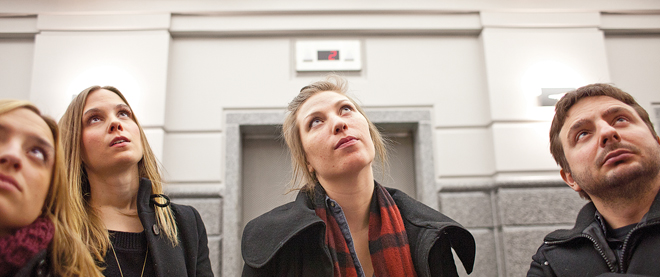The end of the wait for the elevator
Science and industrial design join together to try to make elevators more efficient
Photograph by Jessica darmanin
Share

Professor Myron Hlynka’s office is on the ninth floor of a 10-storey building at the University of Windsor. Many nights, just as he’s in the elevator to go home, Hlynka realizes he’s forgotten something on his desk. Rushing back for the item is never quick: the elevators take what feels like an eternity to arrive, or they stop at nearly every floor along the way. So Hlynka has devised a system to compensate for the elevators’ sluggishness: “What I do is I push the ninth floor and the 10th floor buttons, and when I get off the elevator I push the down button. Then I run to my office,” he says. “Of course, after the elevator stops with me, it goes up even if nobody’s there, it opens the door, it shuts the door, it comes down a floor, it opens the door, and hopefully, by that time I’m there with whatever I’ve forgotten.” Hlynka’s system sounds complicated, but its aim is simple: “I try to cheat!” He suspects he’s not alone. “Everybody tries to cheat in some way.”
Elevators are a universal frustration, at least the slow, cramped and rickety ones, which are all too common. “Wait times and reliability are among the two topics that generate the most complaints” about elevators, says Andrew Wells, an engineer and general manager of KJA Consultants, which helps buildings across Canada implement “vertical transportation systems.” So while the other occupants of Hlynka’s building might not know about his strategy, they will surely empathize with his impatience, and perhaps envy his gumption. He is, after all, a probability researcher with a focus on “queue theory,” or the science of waiting. Most people, Hlynka says, “are always running a little behind. It’s like, if we could just get a bit of extra time—if that elevator would just come faster,” then daily life would be a lot easier, if not better.
Now it appears that the wait for elevators that don’t make us wait may finally be over: a growing number of companies are offering a design innovation that is as simple as it is genius. The floor buttons, typically housed inside the elevator, are increasingly being placed on the outside of the elevator instead of the usual up and down buttons. Known as “destination-oriented dispatching,” this system “gives the elevator all the information that it could possibly [need] in describing who’s moving where,” explains Wells. That one tweak equals major efficiency, with the elevator computer now capable of assigning each person to a certain elevator depending on their desired final stop. Individuals who are going to the same floor are grouped together in one elevator rather than clogging up several elevators, each making duplicate stops. “It’s fascinating,” says Hlynka. “It’s almost like preprocessing.”
The concept of destination-oriented dispatching has been around for a couple of decades, says Wells, who points to a 1985 article in the industry magazine Elevator World. But it’s only been in the last decade that the system has started to catch on, as computer devices have become less expensive and more powerful, while building traffic has ballooned with the preponderance of skyscrapers and condo towers. As such, more companies have begun introducing proprietary versions of this kind of system.
In every case, the companies promise the system will result in dramatic improvements—in some cases claiming as much as a 50 per cent reduction in travel time, and an increased handling capacity of up to 30 per cent. While no independent data exists to show how much better elevators work using destination-oriented dispatching, Wells says there are plenty of factors favouring it. One is lobby organization. Today, “you push a button and then you stand around wondering which elevator is going to go off, and jog over when the light and the bell goes,” he explains. With the new system, the elevator computer “tells you to move over to elevator ‘one’ or ‘D’ or however it’s labelled.” The other benefit: the high-tech system gives the impression of a high-end building, especially as computerized touch screens replace traditional keypads. “It sets the building aside as cutting edge.”
So far, only a handful of Canadian buildings have installed destination-oriented dispatching or plan to, including the Cadillac Fairview Waterfront Centre in Vancouver, but it’s gained traction elsewhere in the world, especially the United States, in major cities including Chicago, San Francisco and New York. Over the next decade, Wells predicts destination-oriented dispatching will become common. But he notes that it isn’t a perfect fit for every building. In places where there are few occupants, it is unnecessary—and could actually cause elevators to be slower since they need to detect that several people are going to the same floor before assigning an elevator to that location.
For Hlynka, though, destination-oriented dispatching is a welcome innovation—much better than others he’s heard of, including the strategic placement of mirrors outside elevators to distract people. “People would push the up button, and then they’d look in the mirror, and comb their hair or straighten their tie, and then the elevator would come.” Pretty soon, says Hlynka, “all the complaints went away about the slow elevators!”